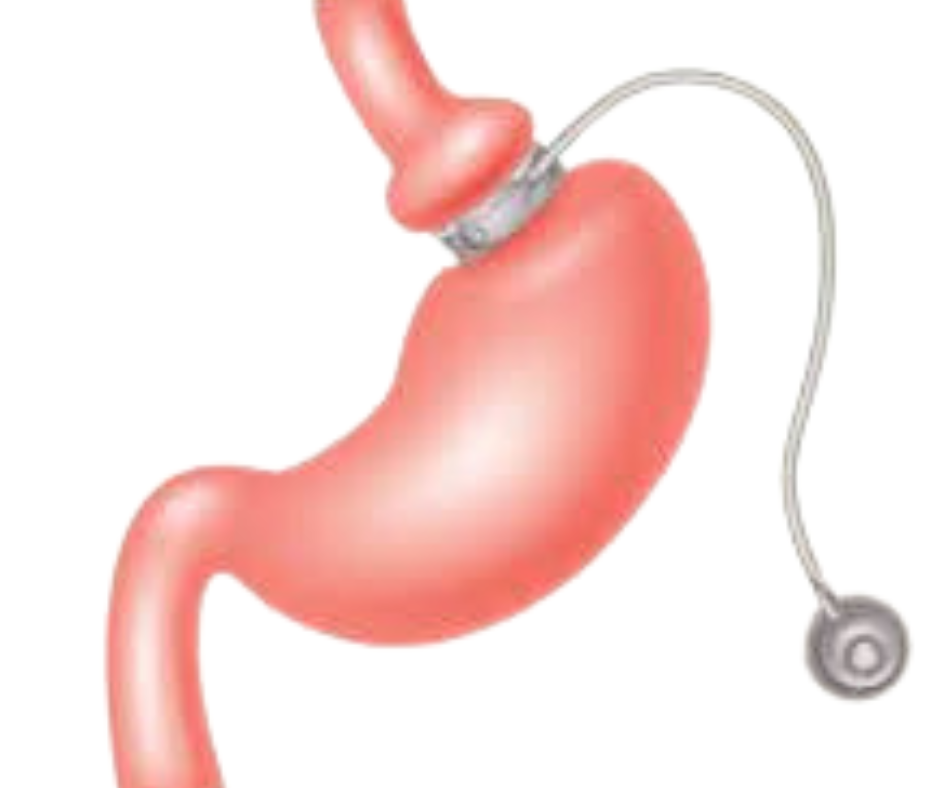Gastric Banding Surgery

What is Gastric Banding Surgery?
Gastric banding surgery, also known as laparoscopic adjustable gastric banding (LAGB), is a surgical procedure that helps individuals with obesity achieve long-term weight loss. This minimally invasive procedure involves placing a band around the upper part of the stomach, creating a small pouch that restricts the amount of food a person can consume. The band is adjustable and can be tightened or loosened as needed to control the rate of weight loss.
The gastric band is made of a silicone material and is placed around the stomach’s upper portion, dividing it into two sections. The smaller upper pouch can hold only a small amount of food, helping patients feel fuller faster and for longer periods. This restriction on food intake leads to reduced calorie consumption, resulting in weight loss over time.
Gastric banding surgery is typically performed laparoscopically, using small incisions and a camera-guided instrument called a laparoscope. This minimally invasive approach offers several advantages, including shorter hospital stays, reduced pain and scarring, and faster recovery times compared to traditional open surgery.
Who is a Candidate for Gastric Banding Surgery?
Gastric banding surgery is primarily recommended for individuals who have a body mass index (BMI) of 40 or higher, or a BMI of 35-39.9 with obesity-related health conditions such as diabetes, high blood pressure, or sleep apnea. It is important to note that gastric banding surgery is typically considered a last resort option after other non-surgical weight loss methods have been unsuccessful.
Candidates for gastric banding surgery should also meet certain criteria, including a commitment to making long-term lifestyle changes and a willingness to adhere to post-operative dietary guidelines. A comprehensive evaluation by a healthcare professional is necessary to determine if gastric banding surgery is the right choice for an individual.
Benefits of Gastric Banding Surgery
Gastric banding surgery offers several benefits for individuals struggling with obesity.
Firstly, it helps patients achieve significant weight loss, resulting in improved overall health and a reduced risk of obesity-related conditions such as diabetes, high blood pressure, and heart disease. Studies have shown that gastric banding surgery can lead to an average weight loss of 50-60% of excess body weight within the first year.
Secondly, gastric banding surgery is reversible and adjustable. The band can be adjusted to control the rate of weight loss, and if necessary, it can be removed without causing permanent alterations to the digestive system. This adjustability makes gastric banding surgery a flexible option for individuals who may require changes in their weight loss journey.
Lastly, the minimally invasive nature of gastric banding surgery allows for shorter hospital stays, less post-operative pain, and faster recovery times compared to traditional open surgery. This means that individuals can return to their daily activities and enjoy an improved quality of life sooner after the procedure.

Risks and Complications of Gastric Banding Surgery
Like any surgical procedure, gastric banding surgery carries certain risks and potential complications. It is essential for individuals considering the surgery to be aware of these risks before making a decision.
One of the potential risks is band slippage or erosion, where the band may shift or erode into the stomach. This can cause discomfort, difficulty swallowing, and may require additional surgery to correct the issue. Another potential complication is band leakage, where the band can develop a small hole or leak, leading to a loss of effectiveness. In such cases, the band may need to be replaced.
Other common complications include infection at the surgical site, bleeding, blood clots, and adverse reactions to anesthesia. It is important for patients to discuss these risks with their surgeon and to follow all post-operative instructions to minimize the chances of experiencing complications.

Preparing for Gastric Banding Surgery
Preparing for gastric banding surgery involves a series of steps to ensure the best possible outcome. This includes consultations with healthcare professionals, lifestyle changes, and mental preparation.
An initial consultation with a surgeon is necessary to determine if gastric banding surgery is a suitable option. During this consultation, the surgeon will evaluate the patient’s medical history, perform a physical examination, and discuss the potential risks and benefits of the procedure. The patient will also have the opportunity to ask questions and clarify any concerns they may have.
In preparation for the surgery, patients will be required to make certain lifestyle changes. This may include adopting a healthier diet, increasing physical activity, quitting smoking, and managing any existing medical conditions. These changes are important for optimizing weight loss outcomes and reducing the risk of complications during and after surgery.
Furthermore, mental preparation is key to a successful gastric banding surgery. It is important for patients to understand the impact the surgery will have on their lifestyle and to mentally commit to the necessary changes. Support from family, friends, and support groups can also be beneficial in preparing for the emotional and psychological aspects of the weight loss journey.
The Gastric Banding Surgery Procedure
Gastric banding surgery is typically performed using a minimally invasive laparoscopic approach. The procedure involves several key steps to place the adjustable band around the upper part of the stomach.
Firstly, the surgeon will make several small incisions in the abdomen and insert a laparoscope, a thin tube with a camera on the end, to visualize the surgical area. This allows the surgeon to perform the procedure using small instruments, minimizing trauma to the surrounding tissues.
Next, the surgeon will create a small pouch by placing the band around the upper portion of the stomach. The band is secured in place using sutures or staples. The band contains an inflatable balloon that can be filled with saline solution to adjust the tightness and restriction on the stomach.
Once the band is in place, the surgeon will test its functionality by injecting saline into the band to ensure it is properly adjusted. The incisions are then closed using sutures or surgical glue.
The entire procedure typically takes around 1-2 hours, depending on the individual’s specific case. Patients are usually able to go home on the same day or after a short hospital stay.
Recovery and Post-Operative Care
Recovery from gastric banding surgery is generally faster compared to other weight loss surgeries. However, it is important for patients to follow post-operative care instructions to ensure a smooth recovery and optimal weight loss outcomes.
After the surgery, patients will be on a liquid diet for a few days, gradually progressing to soft and then solid foods over time. It is important to follow the recommended dietary guidelines provided by the healthcare team to prevent complications and allow the stomach to heal properly.
Pain and discomfort are common in the first few days after surgery, but these can be managed with prescribed pain medications. Patients may also experience bloating, nausea, and difficulty swallowing initially, but these symptoms generally improve as the body adjusts to the gastric band.
Regular follow-up appointments with the surgeon and a dietitian are essential for monitoring progress, making adjustments to the band if necessary, and providing support throughout the weight loss journey. These appointments also offer an opportunity to address any concerns or questions that may arise during the recovery period.
Adjusting the Gastric Band
One of the unique aspects of gastric banding surgery is the ability to adjust the tightness of the band as needed. This adjustability allows for personalized weight loss progress and optimization.
Band adjustments, also known as fills, are performed by injecting saline solution into a port that is connected to the band. This process is typically done in the surgeon’s office and does not require anesthesia. The surgeon uses a fine needle to access the port and add or remove saline to achieve the desired level of restriction.
Adjustments are usually done several weeks after the surgery once the stomach has healed. The number and frequency of adjustments vary depending on the individual’s progress and weight loss goals. Regular follow-up appointments with the surgeon are necessary to ensure the band is adjusted properly and to address any issues or concerns.
It is important to note that the tightness of the band should not cause discomfort or hinder the intake of necessary nutrients. Finding the right level of restriction is crucial to achieving sustainable weight loss without compromising overall health.
Long-Term Success and Lifestyle Changes after Gastric Banding Surgery
Gastric banding surgery is a tool for weight loss, but long-term success depends on making permanent lifestyle changes. The surgery alone will not guarantee sustainable weight loss if healthy habits are not adopted.
Following gastric banding surgery, individuals must commit to a healthier diet and regular exercise. This may involve working with a dietitian or nutritionist to develop a personalized meal plan that is high in nutrients and low in calories. Regular physical activity, such as walking or other forms of exercise, is also important for maintaining weight loss and overall health.
Additionally, individuals must be mindful of portion sizes and eating habits. The small stomach pouch created by the gastric band restricts the amount of food that can be consumed at one time. Chewing food thoroughly and eating slowly can help prevent discomfort and ensure proper digestion.
Regular follow-up appointments with the healthcare team are necessary to monitor progress, address any concerns, and make necessary adjustments to the band. These appointments provide an opportunity for ongoing support and guidance to maintain long-term weight loss success.
Comparing Gastric Banding Surgery to Other Weight Loss Surgeries
Gastric banding surgery is one of several weight loss surgery options available. It is important to understand the differences between gastric banding and other procedures to make an informed decision.
One key difference is that gastric banding is reversible and adjustable, while other weight loss surgeries, such as gastric bypass or sleeve gastrectomy, are permanent and non-adjustable. The reversibility of gastric banding allows for flexibility in weight loss progress and potential removal if necessary.
Another difference is the level of invasiveness. Gastric banding surgery is minimally invasive, whereas procedures like gastric bypass involve re-routing the digestive system. The level of invasiveness can impact recovery times, potential complications, and overall risk.
The choice of surgery depends on an individual’s unique situation, goals, and preferences. It is important to discuss these options with a healthcare professional specializing in weight loss surgery to determine the most suitable approach.
Gastric Banding Surgery Cost and Insurance Coverage
The cost of gastric banding surgery can vary depending on factors such as the surgeon’s experience, geographical location, and hospital fees. It is important to consult with the surgeon and the healthcare team to understand the total cost and any additional expenses that may be involved.
Insurance coverage for gastric banding surgery also varies. Some insurance plans may cover a portion or all of the surgery costs if specific criteria are met, such as a certain BMI or the presence of obesity-related health conditions. It is essential to contact the insurance provider to inquire about coverage and understand any pre-authorization or documentation requirements.
For individuals without insurance coverage or who do not meet the criteria, there may be financing options available through the surgeon’s clinic or other financial institutions. It is important to explore these options and discuss payment plans with the healthcare team.
Finding the Right Surgeon and Clinic for Gastric Banding Surgery
Choosing the right surgeon and clinic for gastric banding surgery is crucial for a successful outcome. It is important to consider several factors when making this decision.
Firstly, it is essential to choose a surgeon who is experienced and specialized in weight loss surgery. Research the surgeon’s qualifications, training, and expertise in gastric banding surgery specifically. Reading patient testimonials and reviews can also provide insight into the surgeon’s reputation and patient satisfaction.
Secondly, consider the reputation and accreditation of the clinic or hospital where the surgery will take place. Look for clinics that are recognized for their excellence in weight loss surgery and have a dedicated team of healthcare professionals to provide comprehensive care throughout the process.
Additionally, consider the location and accessibility of the clinic. Regular follow-up appointments will be necessary, so it is important to choose a clinic that is convenient and easily accessible.
Gastric Banding Surgery Testimonials and Success Stories
Reading testimonials and success stories from individuals who have undergone gastric banding surgery can provide valuable insight and inspiration for those considering the procedure. These stories often highlight the challenges, triumphs, and life-changing experiences associated with gastric banding surgery.
Testimonials can be found on the websites of surgeons and clinics specializing in weight loss surgery. They can offer personal accounts of individuals who have achieved significant weight loss, improved health, and enhanced quality of life as a result of the surgery.
It is important to remember that everyone’s weight loss journey is unique, and individual results may vary. Reading testimonials can provide a sense of encouragement and motivation, but it is essential to consult with a healthcare professional to determine the most suitable approach for each individual.
Conclusion
Gastric banding surgery is a viable option for individuals struggling with obesity and looking for long-term weight loss solutions. This minimally invasive procedure offers several benefits, including significant weight loss, adjustability, and faster recovery times compared to traditional open surgery.
However, it is important to consider the potential risks and complications associated with gastric banding surgery, as well as the necessary lifestyle changes required for long-term success. Consulting with a healthcare professional who specializes in weight loss surgery is crucial for determining if gastric banding surgery is the right choice and for receiving personalized guidance throughout the process.
By understanding the procedure, its benefits and risks, and the importance of post-operative care, individuals can make informed decisions and achieve sustainable weight loss through gastric banding surgery.

